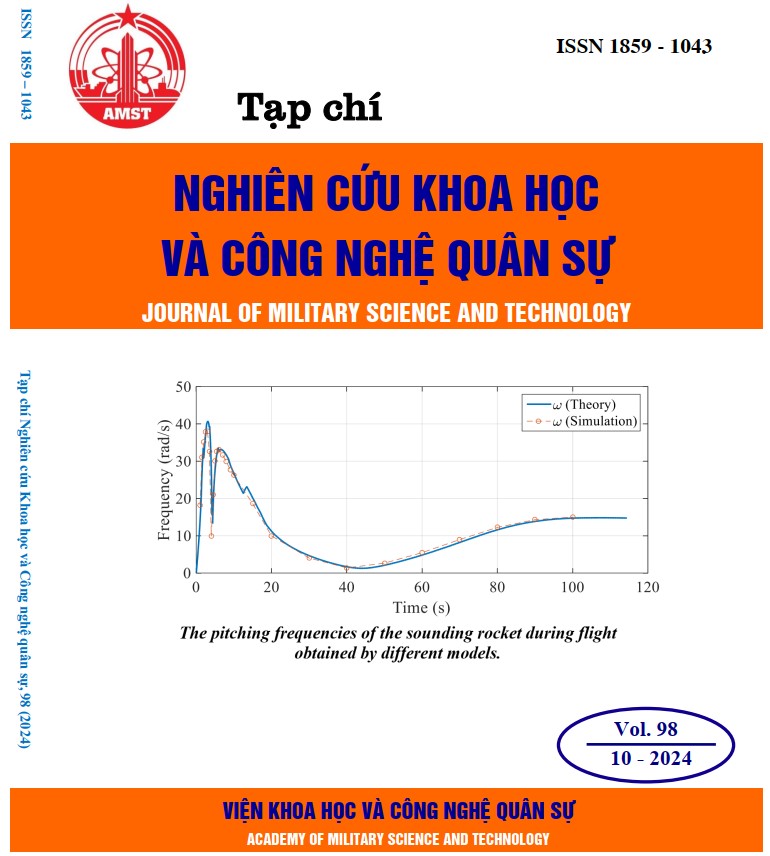Design of a high power combiner in HF band
699 viewsDOI:
https://doi.org/10.54939/1859-1043.j.mst.98.2024.32-41Keywords:
Power combiner; Insertion loss; Isolation.Abstract
Power combiners are commonly used in power amplifiers to achieve high power, especially in long-range and medium-range wireless communication device transmission systems. This paper proposes designing and implementing a high-power two-way power combiner operating in the HF (High Frequency) band, aiming to achieve an output power of over 1 kW. The power combiner is designed, implemented, and tested in the laboratory with the following achieved parameters: insertion loss between output and input better than 3.4 dB and isolation between inputs better than 26 dB. The experimental results showed that the proposed power combiner had better performance than existing combiners on the market. Mainly, power combining efficiency is over 88%, the standing wave ratio at ports is less than 1.25, and the operating temperature of the power combiner is less than 50 °C, meeting the set requirements.
References
[1]. Wilkinson, E.: “An N-way hybrid power divider”, IRE Trans. Microw. Theory Tech., 8, pp. 116–118, (1960). DOI: https://doi.org/10.1109/TMTT.1960.1124668
[2]. Gysel, U.H.: “A new N-way power divider/combiner suitable for high-power applications”. Int. Microwave Symp., Palo Alton, USA, pp. 116– 118, (1975). DOI: https://doi.org/10.1109/MWSYM.1975.1123301
[3]. Barton, T.W., Jurkov, A.S., Pednekar, P.H., et al.: “Multi-way loss less outphasing system based on all-transmission-line combiner”, IEEE Trans. Microw. Theory Tech., 64, (4), pp. 1313–1326, (2016). DOI: https://doi.org/10.1109/TMTT.2016.2531691
[4]. Schellenberg, J.: “The evolution of power combining techniques: from the 60s to today”. Int. Microwave Symp., Phoenix, USA, pp. 1–4, (2015). DOI: https://doi.org/10.1109/MWSYM.2015.7166749
[5]. Walker, J.L.B., Myer, D.P.: “Classic works in RF engineering: combiners, couplers, transformers, and magnetic materials”, Artech House, Norwood, MA, (2006)
[6]. Y. Su and S. Qiang, “Design of Broadband Power Combiner Based on Transmission Line Transformer”, 2022 International Conference on Microwave and Millimeter Wave Technology (ICMMT), Harbin, China, pp. 1-3, (2022), doi: 10.1109/ICMMT55580.2022.10023169. DOI: https://doi.org/10.1109/ICMMT55580.2022.10023169
[7]. Johnson, J.M.: “Four-way non-directional power combiner”. US Patent 6407648 B1, (2002).
[8]. Werlau, B.J.: “High power broad band combiner having ferrite cores”. US Patent 6246299 B1, (2001).
[9]. McLean, J.S.: “Analysis of equal-delay topology for transformers and hybrid networks”, IEEE Trans. Electromagn. Compat., 48, (3), pp. 516–521, (2006). DOI: https://doi.org/10.1109/TEMC.2006.879354
[10]. Pozar, D.M.: “Microwave engineering”, John Wiley & Sons, Inc., Hoboken,NJ, 4th edn, (2011).
[11]. C. J. Kikkert, through AWR Corp, pp. 8-10, Chapter 3 Transformers and Hybrids, (2002-2009).
[12]. 61-Material Datasheet, https://fair-rite.com/61-material-data-sheet/
[13]. M. K. Gourab, R. R. Sahani, U. Mandal and A. Roy, "Design of 2:1 Wilkinson Power combiner for Flight Termination System", 2023 3rd International Conference on Range Technology (ICORT), Chandipur, Balasore, India, pp. 1-5, (2023), doi: 10.1109/ICORT56052.2023.10248985. DOI: https://doi.org/10.1109/ICORT56052.2023.10248985







